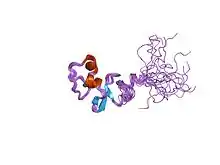| SBP | |||||||||
|---|---|---|---|---|---|---|---|---|---|
 Solution structure of the DNA-binding domain of Squamosa promoter binding protein-like 4 | |||||||||
| Identifiers | |||||||||
| Symbol | SBP | ||||||||
| Pfam | PF03110 | ||||||||
| InterPro | IPR004333 | ||||||||
| PROSITE | PDOC00798 | ||||||||
| SCOP2 | 2lao / SCOPe / SUPFAM | ||||||||
| TCDB | 3.A.1 | ||||||||
| |||||||||
The SQUAMOSA promoter binding protein-like (SBP or SPL) family of transcription factors are defined by a plant-specific DNA-binding domain. The founding member of the family was identified based on its specific in vitro binding to the promoter of the snapdragon SQUAMOSA gene.[1] SBP proteins are thought to be transcriptional activators.
Function
SPB proteins have roles in leaf development, vegetative phase change, flower and fruit development, plant architecture, sporogenesis, Gibberelic acid signaling and toxin response.[2]
Structure
The domain contains 10 conserved cysteine and histidine residues that probably are zinc ligands. The SBP domain is a highly conserved DNA-binding domain. It is approximately 80 amino acids in length and contains a zinc finger motif with two zinc-binding sites: Cys-Cys-His-Cys and Cys-Cys-Cys-His. It has a three-stranded antiparallel beta-sheet.[3]
References
- ↑ Klein J, Saedler H, Huijser P (January 1996). "A new family of DNA binding proteins includes putative transcriptional regulators of the Antirrhinum majus floral meristem identity gene SQUAMOSA". Mol. Gen. Genet. 250 (1): 7–16. doi:10.1007/bf02191820. PMID 8569690. S2CID 20915344.
- ↑ Chen X, Zhang Z, Liu D, Zhang K, Li A, Mao L (2010). "SQUAMOSA promoter-binding protein-like transcription factors: star players for plant growth and development". Journal of Integrative Plant Biology. 52 (11): 946–51. doi:10.1111/j.1744-7909.2010.00987.x. PMID 20977652.
- ↑ Yamasaki K, Kigawa T, Inoue M, Tateno M, Yamasaki T, Yabuki T, et al. (2004). "A novel zinc-binding motif revealed by solution structures of DNA-binding domains of Arabidopsis SBP-family transcription factors". J Mol Biol. 337 (1): 49–63. doi:10.1016/j.jmb.2004.01.015. PMID 15001351.
External links